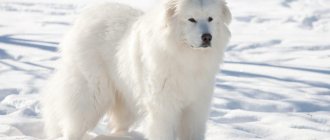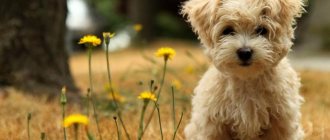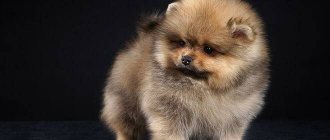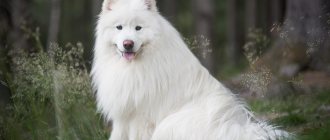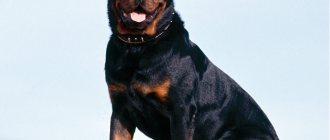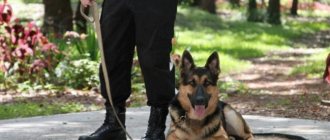A dog is an intelligent animal, and if the owner and pet live in the same rhythm, then both receive joy from communication.
However, the animal and the owner are not always together: work, shopping and other reasons force them to leave the house and leave the pet alone in the apartment. Dogs, depending on their breed and upbringing, cope with periods of separation differently. Often, in moments of sadness, they bark incessantly, and the owner receives comments from neighbors.
The article discusses breeds of quiet dogs that do not know how to bark or do not like to do so.
Basenji
Basenjis are African silent dogs with normal vocal cords, and their uniqueness is explained by the fact that this ancient genus was formed in a time when dogs did not bark. Basenjis can growl, howl, and when highly excited (for example, while hunting), they can emit a cry that vaguely resembles the cry of a jackal or the cry of a child.
The height of the animals is 40-45 centimeters, weight 9-12 kilograms, life expectancy 10-12 years. A distinctive feature of its appearance is the folds on its forehead: the dog seems to be frowning all the time. The presence of “extra” skin is characteristic of the breed: the animal, hunting in the savannah, gets stuck in bushes, roots, between trees, and the “extra” skin helps it wriggle out and slip out of its natural captivity.
The breed is classified as a hunting dog: the dogs are active, agile, restless, and nimble. The disadvantage would be that they must have a leash on walks due to their tendency to run away.
Basenjis are clean, intelligent, loyal, proud, beautiful, beautiful, but very emotional. Pets get along with children, but do not allow themselves to be treated like a toy, so it is not advisable to leave the dog alone with a small child.
Recommended for people who maintain an active lifestyle.
Care and maintenance
Caring for and maintaining a Basenji does not require much effort.
Need to:
- Get vaccinated regularly.
- Periodically treat for fleas and parasites.
- Provide adequate nutrition.
- Basenji is thermophilic, the dog’s place in the house should be warm and soft. It can be a soft kennel house, or a voluminous bed.
- In winter, you should wear overalls for walks.
- Walks should be daily, lasting 2 hours, in any weather, with active movement and games.
- The dog should always have a bowl of clean water.
These are simple rules, but they require daily attention.
Hygiene
The Basenji is a surprisingly clean dog and its presence in the house will not affect the condition of carpets and upholstered furniture.
- The African silent bird does not need to be bathed; it effectively cleans itself. Swimming may cause dermatitis.
- Only puppies should comb out dead epithelium with a hard glove; adult dogs do not need this.
- You should keep your eyes and ears clean. Clean your ears from dirt using cotton swabs.
- The animal wears its claws down during walks, but if necessary, they should be filed.
Basenjis wash themselves like cats, carefully cleaning the face with their paws and the body with their tongue.
Basenji diet
To keep your dog healthy throughout its life, a proper diet is very important. Most of it is lean raw meat and offal. Bones can be given no more than 1 – 2 times a week. Natural food can be alternated or combined with premium dry food.
Cottage cheese and quail eggs must be present in the puppies' diet.
It is very important not to overfeed your pet. The hunting dog should be slightly malnourished.
absolutely unacceptable to treat:
- sweets,
- spicy food
- smoked meats,
- tubular bones.
This can cause irreparable harm to health.
Bernese Mountain Dog
Large, good-natured dogs native to the Swiss Alps have a deep voice, but rarely use it. With its voice, the animal gives a signal to the owner in times of danger or if necessary to attract attention.
These are peasant dogs suitable for hard work, including horse-drawn work for transporting cargo on small carts. Bernese are versatile: they guard the house, herd livestock and look after children.
The height of males is 61-71 centimeters, females - 58-69 centimeters, weight, respectively, 38-50 kilograms and 36-48 kilograms. These peaceful and quiet pets, unfortunately, have a short life expectancy of 6-8 years.
It is recommended to keep the dog in a private home, where it will not be crowded and has more opportunities for energetic runs, and the pet’s sociable nature will make it a faithful friend for families with children.
Rhodesian Ridgeback
The African Lion Hound is a breed of South African hunting dog, bred through selective breeding in the 19th century to guard homes and hunt lions. The name "Ridgeback" comes from the dog's unique appearance - a ridge (ridge) on the back, in which the hair grows in a cone, in two opposite directions. This breed perfectly combines the strength and endurance of a hunter with the devotion and intelligence of a guard. They have unsurpassed vision and sense of smell.
The Ridgeback's character is noble, calm and reserved. However, endowed with remarkable intelligence and the ability to make independent decisions, these dogs require a strong and strong-willed person who can raise them correctly. Possessing a powerful voice, they rarely bark, preferring to silently observe what is happening around them.
Russian greyhound
Graceful, beautiful, photogenic, quiet and generally well behaved dog. The Russian greyhound is inextricably linked with Russian history; it was admired by emperors, princes, the nobility and village landowners. She is a permanent participant in dog hunts, which were organized not only by the royal court, but also by the nobility of the provincial cities.
The animal is distinguished by amazing changes in behavior when changing activities. If in the field she is very active, gambling, even to the point of aggression at the sight of prey, then at home she is ready to lead a passive lifestyle, sitting comfortably at the feet of the owner. A distinctive feature of the greyhound is that it will not try to please its owner and prefers partnerships.
The height of males is 75-85 centimeters, females - 68-78 centimeters, weight - 27-55 kilograms. Life expectancy is 10-12 years.
Recommended for experienced pet owners who have the opportunity to actively walk their dogs.
Silent Dog Breeds
There are many more dogs that simply rarely vocalize. These include many hunting breeds, as well as four-legged animals that love to snore and snort. Such pets do not speak up until the very last moment - when there is a real threat to their own life or the life of the owner.
Akita Inu
The Akita Inu has a well-developed territorial instinct and sensitivity to sounds. These quiet four-legged animals use their voices to warn of danger and to scare away intruders who have already invaded their domain.
Thanks to the unusual anatomy of the mouth, the Akita Inu always has a wide and good-natured smile on its face.
“ More about Akita Inu
Shiba Inu
The Shiba Inu is a miniature copy of the Akita Inu. The relationship of these animals is genetically confirmed, so you should not be surprised at the similarity of their appearance and character.
Despite their silence, Shiba Inus are strong and willful pets, prone to dominance. Raising them requires experience and determination. A love for an active lifestyle will also not be amiss, since Shiba Inus love long walks and trips to nature.
“ More about Shiba Inu
Afghan Hound
Another breed of dog that practically does not bark is the Afghan hound. This long-haired aristocrat has a quiet but very independent character. She demonstrates her passion only when hunting, and among her family it is almost impossible to distinguish her from a cat.
Unlike Akita and Shiba Inu, Afghans are not prone to leadership and aggression towards strangers, but they are very touchy and vulnerable. Unfair punishment and annoying pranks of children can lead them to a nervous breakdown.
“ More about the Afghan Hound
German dog
Despite its impressive size, the Great Dane is the quietest representative of four-legged animals, famous for its high intelligence and gentle character. He rarely barks without a good reason.
If you are not in danger and do not see anything unusual near you, then your pet’s barking indicates banal boredom. Long separation is unacceptable for him, so if you travel frequently, you should choose someone more independent.
Great Danes are sedate and reliable companions with a developed protective instinct. They have a special love for babies, trying to take care of them as if they were their own puppies.
“ More about the Great Dane
Shar Pei
The charming folded Shar Pei is the complete opposite of the playful and cheerful Jack Russell Terrier. Its main features are independence and isolation. When you first meet him, this quiet dog seems rather cold and unsociable, but in fact he is just a typical introvert. Shar Pei does not like large companies and has great difficulty in showing his feelings, which does not change his devotion to his owner.
If you are planning to get this four-legged dog, then keep in mind: the Shar Pei does not get along well with other animals and does not tolerate children's pranks. Its limited field of view deserves special attention. The Shar Pei perceives any sudden movements and sneaking from behind as a potential threat.
“ More about Shar Pei
English bulldog
The English Bulldog is an unusually calm and peace-loving fellow who loves to sleep well and eat well. Unlike the French bulldog, he rarely speaks and prefers to communicate with his owners using grunts and snorts.
Representatives of this breed get along easily with other animals and are patient with children. For this reason, kids with great enthusiasm dress up their pets in dresses and ride them in a stroller.
“ More about the English Bulldog
Bullmastiff
The Bullmastiff's silence is explained by its calm and reserved character. Despite its strength and developed protective instinct, this dog does not attack without the need or approval of the owner.
INTERESTING!
Due to the high pain threshold, the bullmastiff does not react to wounds for a long time. This feature was highly valued during the era of dog fighting.
Bullmastiffs are very kind to those who are weaker than them. They get along easily with cats and never offend children.
Russian greyhound
Another hunting dog breed from the selection is the Russian greyhound. Like the Afghan hound, this pet barks only for business – when chasing an animal. The rest of the time she behaves as calmly and reservedly as possible.
Russian greyhounds are completely devoid of aggression towards strangers and are not suitable for protection. Due to their independent nature, such pets are “little talkative” and do not require the attention of their owners.
A distinctive feature of representatives of this breed is increased excitability. The Russian greyhound has a highly developed instinct of pursuit, so during walks it is kept strictly on a leash. Otherwise, she will immediately chase a cat or other small animal that appears in her field of vision, ceasing to respond to commands shouted after her.
Chow chow
This shaggy dog with the appearance of a bear cub is close in character to the Shar Pei. The Chow Chow is also famous for its restraint and speaks strictly in case of danger.
The four-legged dog shows its love to only one owner. To do this, he uses quiet whining, light poking with his nose and almost imperceptible twitching of the tail.
“ More about chow chow
Newfoundland
Shaggy diving dogs are very friendly and focused on working together with people. They are often used as guide dogs and in police and military services.
Barking is a convenient tool for Newfoundlands to warn others about danger. For this reason, they never use it for trifles.
Despite their large size and impressive strength, Newfoundlands are completely unsuitable for protection. Due to their innate good nature and lack of aggression towards strangers, they need quite a lot of time to assess the situation. A lightning-fast reaction from these dogs can be expected only in one case - if there is a serious threat to the lives of their owners.
“ More about Newfoundland
Saint Bernard
If you are looking for a calm and disciplined dog who loves children, pay attention to the St. Bernard. Thanks to his innate good nature, he quickly finds a common language not only with large animals, but also with very small ones: cats, parrots and even rodents.
Saint Bernards are first-class nannies, directing all their energy to serving their household. They are patient with children's mischief and participate in joint games with great enthusiasm.
“ More about St. Bernard
Saluki (Persian greyhound)
The last greyhound on the list is the elegant Saluki. Like all its close relatives, it was bred to chase and drive game. A Saluki can chase prey in complete silence for several hours in a row and burst into barking only after it has been successfully driven.
These four-legged animals cannot tolerate raised tones. They are equally unnerved by the swearing owner and the neighbors arguing nearby. Screaming is especially difficult for them. Living in an unfavorable psychological climate has a negative impact on the health of the Saluki and leads to prolonged depression.
Persian greyhounds are very reserved in their emotions. Following a person around 24/7 is beyond their understanding. Despite this, they accept with great pleasure sincere affection, which they do not have to beg for.
“ More about Saluki
Shar Pei
Due to the peculiarities of the Shar Pei's skin, namely the folds, the dogs are popular in many countries around the world. Shar Peis are distinguished by courage, strength, excellent watchdog and security qualities, self-confidence and devotion to their owners.
And if a voice is needed, it will be used if necessary to warn the owner about something important.
The dog has a sharp mind, intelligence, and goodwill towards children. We cannot neglect the fact that the Shar Pei is initially aggressive by nature, so its early socialization, demanding training (without rudeness and violence) is required and the pet will develop its best qualities.
Shar Pei height is 45-50 centimeters, weight varies from 18 to 25 kilograms, life expectancy is 9-10 years.
Shar Pei requires active long walks: the more energy he splashes out on the street, the calmer he will behave at home.
Education and training
Due to their independence and natural intelligence, Basenjis are not easy to train. In this process, it is important to limit the pet’s freedom of choice without the use of violence.
One of the main commands, “come to me,” is practiced using a roulette leash.
Release the leash and let the dog move as far away as possible. When the leash ends, give the command “come to me.” Unable to move further away from the owner, the pet will run towards him, you need to reward him, praise him, give him a treat. Commands should be practiced constantly, at different times and under different conditions.
Training and raising a Basenji requires love and patience, and the ability to limit choices without using violence.
Basic principles of education:
- always thank and reward your pet for following commands;
- do not use violence or punishment;
- practice commands constantly;
- The dog should be trained not only individually, but also in a group. She carefully watches and remembers how other group members carry out commands.
From an early age, the dog should be taught that the owner can get into his mouth and get food out of it. This manipulation will help protect the pet if the owner promptly and calmly takes the dirt that he picked up on the street from his mouth.
The dog must eat food in a certain place; do not treat the dog near the table or refrigerator. Then she will climb onto the table and into the refrigerator on her own.
Basenjis require a lot of attention and love; communication with a pet will protect the house from pogroms caused by dogs deprived of attention.
Collie
The Scottish Sheepdog, or collie, gained popularity after the TV series Lassie. The voice of a beautiful collie can only be heard when it is necessary to tell the owner something important. A light, intelligent, graceful dog with long, silky hair and a fox-like muzzle.
The animal gets along well with children and is suitable for active families as a companion. Easy to train. Requires special coat care and high-quality food to avoid skin problems.
The height of males is 56-61 centimeters, females - 51-56 centimeters, weight - 19-34 kilograms. Life expectancy is 12-15 years.
Collies require active walks without a leash; the dog can easily cover three kilometers a day.
Saint Bernard
In appearance and temperament they resemble Bernese Mountain Dogs. Saint Bernards were bred specifically to rescue people on the Great Saint Bernard Pass in the Swiss Alps. They lived in a hospice for travelers, named after the Italian monk Bernand Menton.
I make fluffy pancakes with just two ingredients: cheese and eggs.
The Dobronravov dynasty shared new photos and a collage. Fans are delighted
A swan remains faithful all its life: interesting facts from the life of beautiful birds
There is at least one recorded case of one of these dogs carrying a large barrel of brandy attached to its neck to help avalanche victims stay warm while awaiting rescue. This adorable image has often appeared in pictures and has been shown on television.
Deerhound (Scottish Deerhound)
A large breed, it belongs to the hunting greyhound (hunting) dogs. Deerhounds are hardy, hardworking, calm, balanced and endlessly loyal to their owner. Thanks to their natural breed characteristics, they show good results in sports competitions.
The Scottish Deerhound breed is a quiet breed and does not actually bark. Animals are able to understand the mood of the owner and will not bother him at the wrong time.
The height of males reaches 76 centimeters, for females - 71 centimeters, weight 50 kilograms or more. Life expectancy is 10-12 years. The appearance of such a giant seems gloomy, but the dog gets along well with children and is not aggressive. In Russia, the Deerhound dog breed is considered rare.
A city apartment is not suitable for keeping a dog of impressive size; a country house would be an excellent option, where you can arrange a large area for active walks and training.
What dogs can't bark at all?
The only non-barking dog breed in the world is the Basenji. The absence of barking is explained by the specific structure of the pharynx, which prevents the formation of a characteristic sound. Despite this feature, it cannot be said that this dog is completely without a voice. Instead of the usual yelps, she communicates using purrs, howls, snorts and whines.
Another advantage of representatives of this breed is the absence of an unpleasant odor. Basenjis are famous for their cleanliness and take care of their own hygiene, licking themselves like cats.
“
More about Basenji
Results
Basically, people do not know about dogs that have a complete lack of barking ability or simply do not use it. In addition to the above breeds, there is a whole list of dogs that, due to their character and nature, do not bark without a particular reason.
Such dogs can bark only in emergency, dangerous situations, when it is necessary to defend the family, or to attract the attention of the owner. When bringing a dog, especially into an apartment, take into account such factors as barking, as a quiet dog will become a more pleasant neighbor for you
When bringing a dog, especially into an apartment, take into account such factors as barking, as a quiet dog will become a more pleasant neighbor for you.
https://kot-pes.com/porody-sobak-dlya-kvartiry/https://porodadog.ru/porody-sobak/ne-layushhie-porody-sobak.html
Health
Basenjis most often suffer from de Toni-Debreu-Fanconi syndrome, a congenital disease that affects the kidneys and their ability to reabsorb glucose, amino acids, phosphates and bicarbonates in the kidney tubules. Symptoms include excessive thirst, excessive urination, and glucose in the urine, which is often mistaken for diabetes.
It usually appears between 4 and 8 years of age, but can begin at 3 or 10 years of age. Toni-Debreu-Fanconi syndrome is curable, especially if treatment is started on time. Owners should check urine glucose levels once a month, starting at age three.
The average lifespan is 13 years, which is a year or two more than other dogs of similar size.




